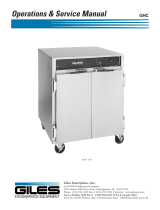
Bettis P/N 074651E
Revision “D”
Page 1 of 4
1.0 GENERAL
1.1 Bettis ninety degree rotary actuators are designed for use with quarter turn
devices of a broad range of sizes and types, and are applicable over a wide
range of pressures, temperatures and environments.
1.2 This service procedure is offered as a general guide for the following Bettis
Double Acting and Spring Return Series Hydraulic Actuators: 121, 221, 231, 331,
2210, 25420, 2521, 2542, 3420, 3531, 3542, 35310, 35420, 4031, 4515, 4531,
CRD3515, H35, HD521, HD522, HD721, HD722, HD731, HD732, F, FQ, G, GC,
GH, GHC, GTD, GTO, MR2150, MR3150,T, TRQ10, AND STRQ10. NOTE: The
listed actuator series include M2, M3, M4, M6, M7, M9, and M11 overrides plus
the early Bettis model numbers that have an alpha character following the basic
model letters and numbers (i.e. HD732A, 301B, T402.0A etc).
2.0 STORAGE
2.1 For applications where a hydraulic actuator is not put into immediate service it is
recommended the actuator be cycled (i.e. two complete strokes – one clockwise,
one counterclockwise) a minimum of 5 times with regulated clean/dry pneumatic
pressure once a month. Care should be taken to plug all open ports on the
actuator and all controls to keep out foreign contaminates. Some plugged
pressure ports need to be unplugged during each months cycling procedure to
enable un-pressured areas to vent to atmosphere. After each cycling procedure
is complete care should be taken to replace any removed plugs to keep out
foreign contaminates during storage.
2.2 Indoor storage, if available, is recommended. Actuators should not be stored in
an atmosphere harmful to resilient seals.
2.3 After long term storage the actuator may require the installation of a service kit
before being placed into service.
3.0 INSTALLATION
3.1 Since there are many valve and actuator combinations, it is not practical to
include detailed instructions for each type. Mountings are designed to be as
simple as possible to keep guess work out of installation.
3.2 Actuators are shipped from the factory with the travel stops adjusted for
approximately ninety degree rotation. Generally it is necessary to make slight
travel stop adjustments once the actuator is installed on the valve. Refer to the
valve manufacturer's recommendations for specific requirements. When the
valve has internal stops, the actuator should be adjusted at the same points.
NOTE: The actual "stopping" should be done by the actuator. If the valve does
not have internal stops, adjust the actuator to the full open position. Using this as
a reference point, rotate the valve closed and adjust to the valve manufacturer's
specifications for total rotation.





